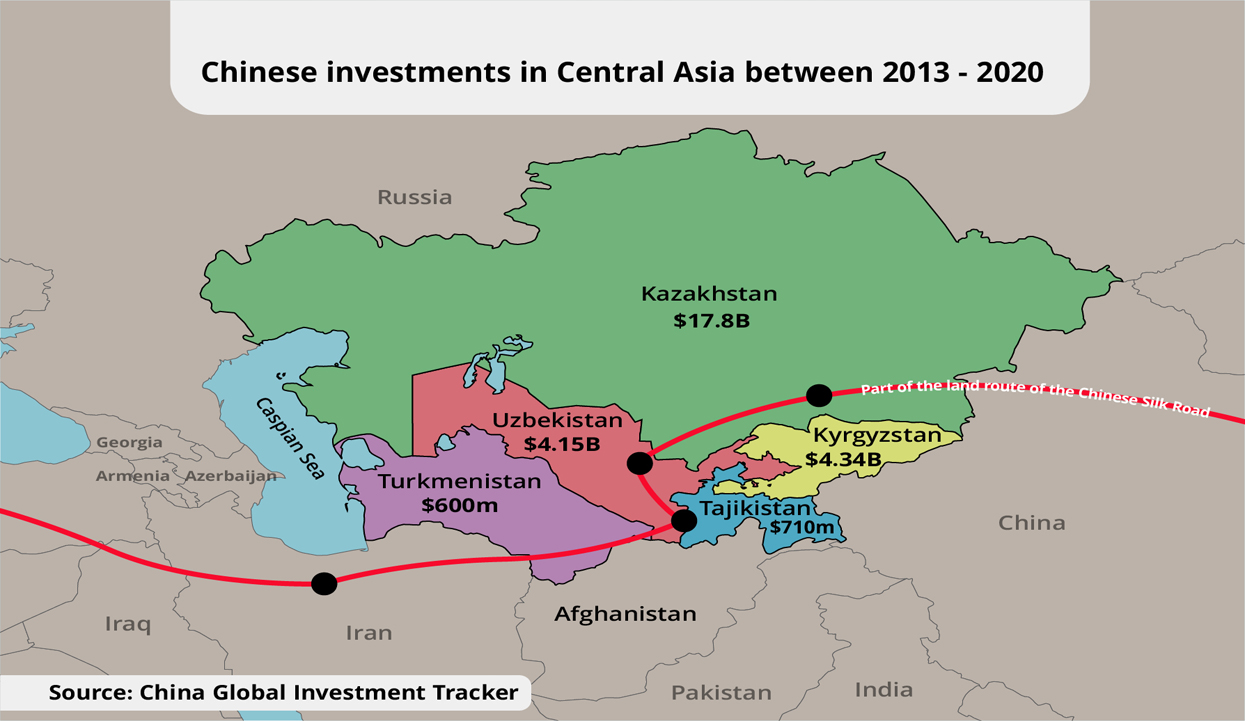Coinciding with the withdrawal of US troops from Afghanistan, President Joe Biden tweeted, “this decision about Afghanistan is not just about Afghanistan. It’s about ending an era of major military operations to remake other countries,” referring to the end of decades of US military interventions around the world, more precisely to remake other countries, as a result of the failure to achieve the military campaigns’ objectives in Afghanistan and Iraq.
US intervention in Afghanistan for the past 20 years has not been enough to eliminate or even weaken the Taliban, as evidenced by its ability to hold power in Afghanistan following the start of US forces' withdrawal. It is an event that will leave political dimensions and changes reverberating around the world. However, Central Asian countries stand out at the center of geopolitical changes, as they are the most concerned countries in the accelerating developments in the Afghan internal scene.
Among Central Asian countries, the countries on the northern borders of Afghanistan, Tajikistan, Uzbekistan and Turkmenistan, seem the most vulnerable to the security and political repercussions compared to Kazakhstan and Kyrgyzstan.
Central Asia and the Response to Taliban Control
So far, the Taliban have not appeared to be a direct threat to the security of these countries. Yet, historically, the Taliban's negative role with Central Asian countries has always been a reason for greater concern and anticipation, leading these countries towards increasing their military presence and defensive actions on the borders with Afghanistan.
The years of Taliban rule from 1996 to 2001 saw central Asian countries suffer huge financial and human losses, as a result of the escalation and proliferation of several terrorist organizations that were supported by the Taliban and gave the oath of allegiance (Bay’ah) to Mullah Omar. Among these organizations are the Islamic Movement of Uzbekistan 1998, Caucasus Emirate 2007 which was active on the bank of the Caspian Sea and posed a threat to Turkmenistan and Kazakhstan, as well as the Uyghur armed organization known by several names, including the Islamic East Turkistan Movement, which is demanding the independence of northwest China's Xinjiang province and accused by the Chinese government of a series of terrorist operations, posing a threat as well to the western borders of Tajikistan and Kyrgyzstan.
Despite that, these countries today show that they are more willing to deal with the repercussions of Taliban control than they were in 1996, and a number of them, excluding Tajikistan, maintain constant contact with the Movement. However, they still have to respond to a number of challenges, the most important of which are the issue of refugees and the increasing activities of terrorist and criminal organizations, raising concerns about terrorist operations or the flow of more drugs across borders, as well as fears of an infight scenario in Afghanistan.
Refugees
Central Asian countries bordering Afghanistan have witnessed negotiations aimed at temporarily receiving a number of collaborators with US and Western forces until their subsequent transfer, let alone the flight of hundreds of Afghan soldiers to Tajikistan and Uzbekistan after the Taliban took control of the border areas in late July and early August.
For Tajikistan, which has announced that it will not receive Afghan refugees after receiving more than 15,000 refugees in recent years. The ban is part of a Kremlin rejection, with Russian President Vladimir Putin saying he does not want extremists to infiltrate his country under the guise of humanitarian asylum, and has called on Central Asian countries to take similar action, as travel and movement between Russia and Central Asian countries take place without the need for visas.
Terrorism
There are fears that the Taliban's rise would revive the terrorist groups that central Asian countries have struggled to defeat. New generation of extremists may see in Taliban's success an opportunity to renew themselves or take advantage of Afghanistan’s security vacuum to attack neighboring countries, let alone the threats of ISIS-Khorasan which has demonstrated the ability to benefit from conditions and factors in Afghanistan in carrying out a terrorist attack on Kabul airport on August 30, with the possibility of further attacks targeting Afghan border crossings, institutions and vital facilities.
Civil War
US Chief of Staff Mark Milly said there is a high probability of a civil war in Afghanistan, a scenario that many countries around the world are taking seriously, and remains in place even with the Taliban's September 6 announcement of full control of Panjshir province. Fighting between the Taliban and the National Resistance Front is likely to continue and expand to other areas as part of infighting or as part of an agency war, one part of which is international and regional forces that want to impose their vision on the Taliban.
The military action of the Front may move to the stage of targeting individuals, with the use of the ethnic cover of the Tajik ethnicity for these activities, as the majority of the fighters of this front are Tajiks, which make up 37% of the Afghan population.
Central Asia in its regional context
Afghanistan has once again returned to the strategic dimensions of the Central Asian region, particularly in the positions of Russia which plays security roles in Central Asia through its military bases in Tajikistan, such as the Dushanbe base and the Kulob base, about 100 km from the Afghan border. China is economically active in Central Asia due to the region's centrality in the Belt and Road project, as it geographically connects the European and Asian continents, as well as the Arab region and Iran.

Thus, the US withdrawal has certainly left a security vacuum and a large strategic space in Afghanistan, which could adversely affect stability in Central Asia as a whole. As stability in the region depends on a balance of Russian security and a Chinese development outlook, the last thing the two countries would want is chaos in Afghanistan.
The two countries are therefore demonstrating a remarkable effort to contain Taliban and cooperate with it in an attempt to modify its political behavior, particularly to maintain the security of their borders and establish utilitarian relations with their neighbors. Russia's reassurance towards the Taliban can be read in the statement of the Russian Presidential Envoy to Afghanistan, Zamir Kabulov saying that Russia does not regard the Taliban as a threat to Central Asian countries, as well as visits by a Taliban delegation to Russia and China— a message that the country will not be a springboard for acts of sabotage or terrorism. But the dimensions of the changes in Afghanistan seem more beneficial for China, which is considering the country's geographical role in supporting the future of its Belt and Road projects, according to what the Chinese Foreign Ministry issued on several occasions about the country’s desire to provide the necessary economic support for the reconstruction of Afghanistan.
Hence, changes in Afghanistan offer opportunities as well as challenges for Russia and China. Perhaps the central issue is the withdrawal of US forces as the latest form of US military presence in the Central Asian region in its broader geographical sense, including Afghanistan, Pakistan, and northeastern India after the closure of the US air base in Kyrgyzstan in 2014, as the region has not hosted US bases for nearly six years.
Accordingly, the results of good relations between the Taliban government and Russia and China will be reflected in the Central Asian region in:
1. Building balanced relations between the Central Asian countries and the Taliban by virtue of their geostrategic reality.
2. The possibility of providing a near-clear course of economic development and a Russian-Chinese bilateral diplomatic cover for politically taming the Taliban and thus its ability to run the State like any normal political current.
3. Prompting the Taliban to seek to strengthen its interests and secure its northern borders so militants would not have access to Central Asia.
Taliban and Infrastructure Projects in Central Asia
Central Asian governments are taking various positions from the rapid changes in Afghanistan. Statements by leaders and officials in Uzbekistan and Turkmenistan indicate a desire to establish relations with the Taliban that ensure good neighborliness and maintain dialogue, while statements from the Tajik capital of Dushanbe appear less optimistic.
In fact, the Central Asian countries have many mutual economic projects and interests. Turkmenistan is seeking to complete the "TAPI" gas pipeline project or the Turkmenistan-Afghanistan-Pakistan-India gas pipeline, which is scheduled to transport gas from the "Galkynsh" field in Turkmenistan through a 1,600 km pipeline to India, passing through Afghanistan and Pakistan. Although the project has been on the table between Pakistan and Turkmenistan since 1995, the war in Afghanistan and then the US invasion prevented its implementation.
Another project for the transmission of electricity between Turkmenistan and Pakistan through Afghanistan is known as the TAP500 KV line, which is still under technical studies unlike the first which is being worked on extensively. These two projects are jointly and coordinated with the Asian Development Bank. Through more research, it was found that there is a project to transfer energy from Kyrgyzstan to Pakistan via Tajikistan, under the name, Central Asia-South Asia Regional Energy Market (CASAREM), which aims to transfer gas from Central Asia to South Asia.
The Central Asian States certainly view these projects as a tool for promoting stability and peace in the region. Turkmenistan and Uzbekistan are likely to continue their projects with their partners in internal Afghanistan even in isolation from the directions of the new Afghan Government, while security considerations appear to be at the center of Tajikistan's outlook rather than economic interests.
On the other hand, there is an urgent need for the Taliban to participate in economic projects with neighboring countries in order to respond to economic challenges that may threaten the future of its control. The Taliban, through its messages and statements, shows a stronger desire than before to join the international community and deepen its economic relations, particularly with the member states of the Shanghai Organization.
Accordingly, the economically and security complex landscape is no longer related to US influence in Central Asia, which is likely to be placed in Southeast Asia in the medium term, but is left to other international and regional powers to fill the void with a path that will be qualitatively different from the past 20 years, given that the aspirations of these countries are primarily different from their American counterparts.
In the end, Central Asian countries are showing their ability to adapt to a government controlled by Taliban leaders, as they have done in the past. However, key issues of response on the borders of these countries emerge, such as the issue of refugees and terrorist threats. For its part, the Movement seeks to show its capabilities to fight terrorist organizations, notably ISIS, as well as its willingness to engage in confidence-building measures, as it seems to recognize the importance of economic interests in the permanence of states.
Yet, security concerns remain for Central Asian countries, especially since the Taliban's historical experience has been a factor in threatening its neighbors. Also, many factors remain alarming; such as the Taliban's mismanagement of the country's complex demographic composition, or the further deterioration of the economic situation— all of these are challenges that will become more apparent in the future.
Keep in touch
In-depth analyses delivered weekly.

Related Analyses:







.jpg-%D8%A7%D9%93%D8%B3%D9%8A%D8%A7-%D8%A7%D9%84%D9%88%D8%B3%D8%B7%D9%89-%D8%AA%D8%AD%D8%AA-%D8%A7%D9%84%D9%85%D8%AC%D9%87%D8%B1-%D8%A8%D8%B9%D8%AF-%D8%B3%D9%8A%D8%B7%D8%B1%D8%A9-%D8%AD%D8%B1%D9%83%D8%A9-%D8%B7%D8%A7%D9%84%D8%A8%D8%A7%D9%86-%D8%B9%D9%84%D9%89-%D8%A7%D9%94%D9%81%D8%BA%D8%A7%D9%86%D8%B3%D8%AA%D8%A7%D9%86.jpg)

.jpg)
-%D8%A7%D9%81%D8%BA%D8%A7%D9%86%D8%B3%D8%AA%D8%A7%D9%86-%D8%AA%D9%86%D9%87%D8%A7%D8%B1.jpg)
.jpg-%D8%B7%D8%A7%D9%84%D8%A8%D8%A7%D9%86-%D8%A7%D9%81%D8%BA%D8%A7%D9%86%D8%B3%D8%AA%D8%A7%D9%86.jpg)